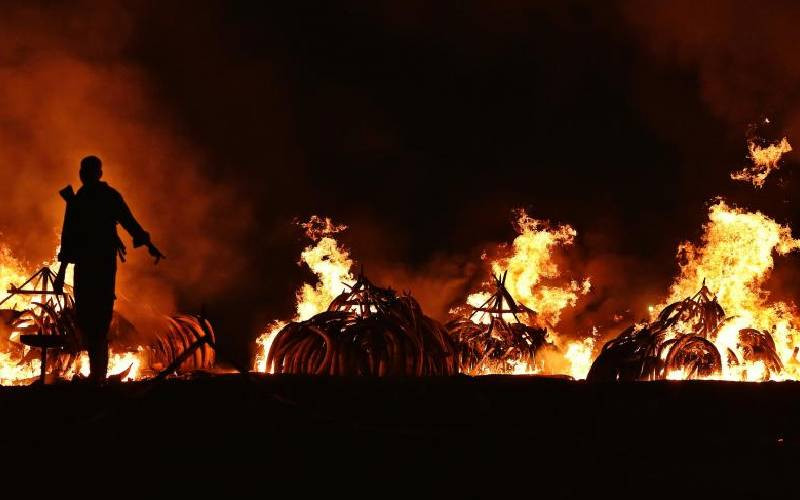In the words of Ian Craig, a KWS board member and manager of the Northern Rangelands Trust: “There is no doubt that Kenyan elephants are in crisis with figures indicating that at least six jumbos are killed monthly in Kenyan National Parks for their tusks. I received daily messages of poached elephant carcasses and injured elephants. The first three months of this year looked as if we were heading for our worst year on record.”
Now that is not a good speech. Not good news. And definitely a sizeable and worrisome step backwards. As we revisit the renewed assault on the world’s largest gentle giant on land, the elephant, we must from the outset make it clear that the punishment meted out on poachers does not in any measure act as a deterrent against the bloody trade in game trophies.
The rape and pillage of our national heritage of wildlife is unacceptable and poaching a clear and present danger to the basic elements of the golden goose of our second most valuable resource: tourism revenues.
What is emerging is that resurgence in thirst for game trophies in East Asian markets is complicating and depleting animals in our game parks. The high risk-high return world of game hunters has spawned a new, sophisticated and moneyed breed of cartel that would stop at nothing to quench the thirst for ivory, rhino horn, rare animal species, leather and fur clients.
state-of-the-art
Backed by “Big Money” and wheeler-dealers who have operatives doing their bidding in conservancies, government offices and entry/exit points for a little consideration will always prove a hard nut to crack. It is hard to make anti-poaching efforts make an impact if the “disease” is eating our park animals from within — grand corruption!
Again flush with such financing, poachers can now reportedly afford state-of-the-art rifles, night vision equipment that would put most armies to shame and easier maneuvering though cracks in the system and across borders.
Indeed, the latest data from Lusaka Agreement Task Force shows that between 2000 and 2011 at least 77 incidents of wildlife specimen seizures were made at various entry/exit points in the Far East.
The dark side of that report is that the seizures which originated from Africa included 78,327.98kgs of ivory, 42 rhino horns and over 630 assorted live animals as well as over 300 African grey parrots. Should we panic?
Yes! The last elephant census put their total at 37,000, but considering that in 1989 the numbers were down to 16,000 meant conservation, electronic tagging, fencing of parks and conservancy/group ranch efforts were paying off handsomely.
Considering 13 poachers have already fallen to the bullet since the beginning of this year, 165 dragged through the courts of law and guns and ammunition recovered, the Kenya Wildlife Service, Kenya Police, Kenya Forest Service, Customs and Immigration officers deserve unqualified commendation. And let’s not forget the five game rangers that lost their lives in the course of this noble duty.
Let us not just address elephant populations but hippos, crocodiles, geckos, parrots and birdlife as well. Then again let the authorities mark the hotspots such as the Abrades and Northern rangeland, Stave East, Narok, and Lamu County. Increase the KWS budget for engagement of more game rangers, training and purchase of better equipment.
Engage the governments at even Head of State level on this matter that touches on a perishable heritage. If need be, peg future relations on the friendly nations’ willingness to adhere to the covenants Kenya and majority of the international community signed under the Convention on International Trade in Endangered Species of Wild Fauna and Flora, also known as the Washington Convention (CITES) the protocol drawn up in 1973 to protect wildlife against over-exploitation, and to prevent international trade in species threatened with extinction.
hop-about wallabies
Who would dare imperil the panda that is the pride of China? Would India allow any visitor to harm the beautiful tiger or South Africans their wide array of animals? Is the wolf not protected in parts of the US where it was once thought extinct?
Stay informed. Subscribe to our newsletter
And why does Canada go to such great lengths to ensure the bear population is not tampered with or the Australians their hop-about wallabies? In Sri Lanka where the astounding ivory haul was arrested, we would like to believe Colombo, whose prized tea bushes are a lifeline for the economy, would not like to see a Kenyan “tea poacher” poisoning or otherwise uprooting their heritage.
Our concern for our animal stocks stems from the very same desire to enjoy the diverse inhabitants of Mother Earth without upsetting the balance. Is that too much to ask?
 The Standard Group Plc is a
multi-media organization with investments in media platforms spanning newspaper
print operations, television, radio broadcasting, digital and online services. The
Standard Group is recognized as a leading multi-media house in Kenya with a key
influence in matters of national and international interest.
The Standard Group Plc is a
multi-media organization with investments in media platforms spanning newspaper
print operations, television, radio broadcasting, digital and online services. The
Standard Group is recognized as a leading multi-media house in Kenya with a key
influence in matters of national and international interest.
 The Standard Group Plc is a
multi-media organization with investments in media platforms spanning newspaper
print operations, television, radio broadcasting, digital and online services. The
Standard Group is recognized as a leading multi-media house in Kenya with a key
influence in matters of national and international interest.
The Standard Group Plc is a
multi-media organization with investments in media platforms spanning newspaper
print operations, television, radio broadcasting, digital and online services. The
Standard Group is recognized as a leading multi-media house in Kenya with a key
influence in matters of national and international interest.








